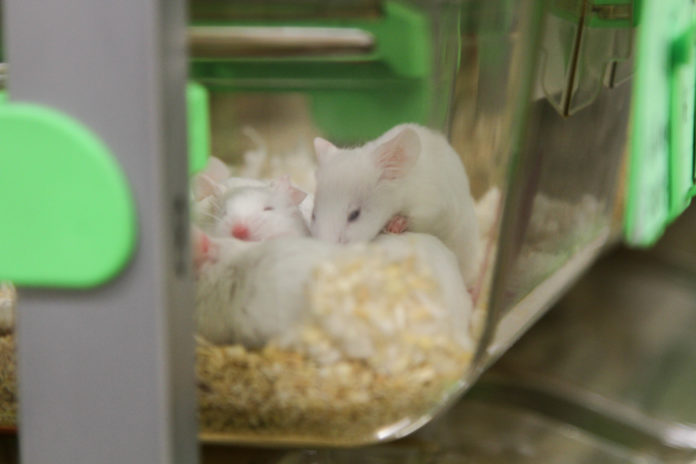
By Brooke Hill | Copy Editor
On the fifth floor of the Baylor Sciences Building, officially known as the penthouse level, lie labs full of animals used for Baylor students’ research.
As attending veterinarian and animal program director, Dr. Ryan Stoffel oversees the animals. Federal regulations require both positions to run a research lab.
Long hallways filled with big metal doors are in place to keep the animals from getting sick, according to Stoffel.
The laboratory was renovated in a $5 million project about a year and a half ago, said Dr. Deborah Holland, assistant vice provost for research and director of compliance.
Stoffel said the lab is home to around 1,800 mice, 60 rats and around 1,500 fish. He said the numbers fluctuate when they intentionally breed the animals.
Stoffel said despite the more popular idea that albino mice are more likely to be tested, the most popular type of testing mice are a strand of black mice. He said mice are typically preferred for research because they’re easy to genetically modify.
The mice are also grouped socially when possible. This means that instead of living in individual cages, they are often placed in groups of four to five mice per cage. Stoffel said they try to make the spaces the mice are kept in as hospitable as possible, even in a laboratory setting.
Baylor’s department of psychology and neuroscience does behavioral testing on the animals, including topics such as anxiety, memory, learning, seizures and autism. There are also researchers studying breast cancer and hearing and deafness.
Both graduate and undergraduate students take part in the research, said Stoffel.
“They can do some of the behavioral testing, things like a T maze, and then depending where the mouse goes, that’s relevant to the study,” Stoffel said. “Certain mice, if they’re anxious, or if the autism mice behave differently than a normal mouse would, those situations are of importance.”
When a student wants to begin research, they must first talk to Stoffel about whether there is room, both physically in the labs and in the program, and if there is available equipment to fulfill their idea and to explain their thoughts. Once they have their idea clearly identified, they submit it to the Institutional Animal Use and Care Committee board, which reviews the proposal for certain criteria. The board may request modifications or clarifications.
If the protocol is approved, there are lots of trainings, Stoffel said. Some are computer-based trainings about what regulations researches need to be aware of, while others are hands-on, to get students used to routine procedures such as injections or blood collection.
There are two full-time animal care staff workers whose job is to do daily health checks. All animals undergo daily wellbeing checks per federal regulations. The veterinary staff, animal care staff and research staff work closely with facility services to ensure the best possible living conditions for the animals, said Stoffel.
“Obviously with having live animals in the facility, if something goes wrong, we can remedy it quickly to make sure there’s not any adverse effects on the animals,” Stoffel said. “We have additional monitoring systems throughout the facility that alert us if any of these environmental parameters — temperature, humidity. For whatever reason if they go out of range, they notify us so even after work we can take care of those issues if they pop up.”
Stoffel said students’ research will typically be published in a scientific journal or will be used to apply for funding, which could lead to subsequent research once their study is completed. Most of the animals will end up being euthanized.
“Outside of research, there’s not much demand for mice and rats,” Stoffel said. “Most of the animals do end up getting euthanized. We try to limit the number of animals used in every project. When the committee reviews it, one of our goals is to make sure they’re using an appropriate number of animals. You need to use enough animals to get significant data from it, but on the flip side, we don’t want researchers using too many.”
Holland said the 3 R’s — reduce, refine and replace — are three standards researchers live by in an effort to do the most good.
“Some projects do include painful procedures like surgery or things like that. So any time we can refine those projects to do something that’s not painful, obviously that’s one of the committee’s roles,” Stoffel said.
Holland said that whenever possible, they encourage researchers to use other types of testing that doesn’t involve animals.
Stoffel said humans and animals can develop adverse reactions to each other. He said it’s not unusual for animal workers to develop allergies, but humans can transport sicknesses to the animals, too.
“Biosecurity is a very important part of everything we do, so almost every practice that we have tries to limit the exposure of animals to something that could be in the environment,” Stoffel said. “Not just for animal welfare, but we don’t want to interrupt research. It’s very expensive if mice get sick. There’s a number of things that they can get, so we try to limit what gets in.”





